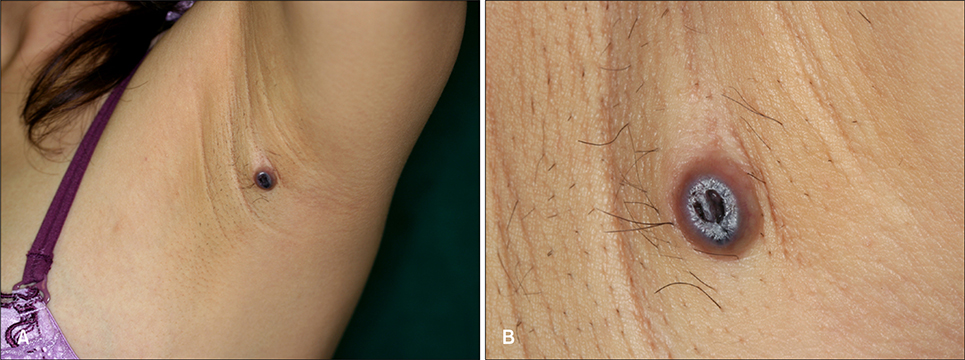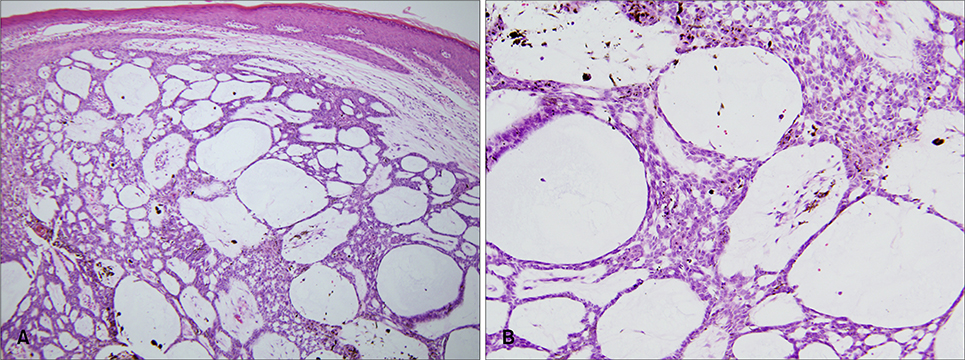Ann Dermatol.
2008 Mar;20(1):22-25. 10.5021/ad.2008.20.1.22.
A Case of Axillary Adenoid Basal Cell Carcinoma
- Affiliations
-
- 1Department of Dermatology, College of Medicine, Dongguk University, Gyeongju, Korea. smg@dongguk.ac.kr
- 2Department of Pathology, College of Medicine, Dongguk University, Gyeongju, Korea.
- KMID: 2156355
- DOI: http://doi.org/10.5021/ad.2008.20.1.22
Abstract
- Basal cell carcinoma (BCC) is the most common skin cancer with a steadily increasing incidence. Ultraviolet radiation is considered the single most important risk factor for BCC, because the tumor occurs most frequently in sun-exposed areas of the body, with approximately four of five BCCs occurring on the face. BCC occurs infrequently in non-sun-exposed skin. The axilla is one of the most sun-protected areas of the body, and BCC arising at this site is very rare. We herein report a case of adenoid BCC which arose from the axilla in a 33-year-old woman.
Keyword
MeSH Terms
Figure
Cited by 1 articles
-
Basal Cell Carcinoma on the Pubic Area: Report of a Case and Review of 19 Korean Cases of BCC from Non-sun-exposed Areas
Jin Park, Yong-Sun Cho, Ki-Hun Song, Jong-Sun Lee, Seok-Kweon Yun, Han-Uk Kim
Ann Dermatol. 2011;23(3):405-408. doi: 10.5021/ad.2011.23.3.405.
Reference
-
1. Crowson AN. Basal cell carcinoma: biology, morphology and clinical implications. Mod Pathol. 2006; 19:Suppl 2. S127–S147.
Article2. Song ES, Cho BK, Kim SY, Kim SN, Suh KS, Son SJ, et al. A clinicopathological study of basal cell carcinoma in Korean patients. Korean J Dermatol. 2000; 38:762–771.3. Pon K, Trauner MA, Rogers GS. Axillary basal cell carcinoma. Dermatol Surg. 2001; 27:415–416.
Article4. LeSueur BW, DiCaudo DJ, Connolly SM. Axillary basal cell carcinoma. Dermatol Surg. 2003; 29:1105–1108.
Article5. Choi MH, Ko NY, Kim IH, Kye YC, Kim SN. Three cases of basal cell carcinoma of the axilla. Korean J Dermatol. 2006; 44:887–889.6. Woo SH, Kim IH, Son SW. Axillary basal cell carcinoma. J Eur Acad Dermatol Venereol. 2006; 20:222–223.
Article7. Lee SY, Park SH, Hong JS, Rhee CH, Yun SK, Kim HU, et al. A case of axillary basal cell carcinoma. Korean J Dermatol. 2007; 45:758–760.8. Gardner ES, Goldberg LH. Axillary basal cell carcinoma: literature survey and case report. Dermatol Surg. 2001; 27:966–968.
Article9. Gibson GE, Ahmed I. Perianal and genital basal cell carcinoma: a clinocopathologic review of 51 cases. J Am Acad Dermatol. 2001; 45:68–71.
Article10. Heckmann M, Zogelmeier F, Konz B. Frequency of facial basal cell carcinoma does not correlate with site-specific UV exposure. Arch Dermatol. 2002; 138:1494–1497.
Article11. Ceilley RI, Del Rosso JQ. Current modalities and new advances in the treatment of basal cell carcinoma. Int J Dermatol. 2006; 45:489–498.
Article
- Full Text Links
- Actions
-
Cited
- CITED
-
- Close
- Share
- Similar articles
-
- A case of adenoid basal cell carcinoma in uterine cervix
- A Case of Adenoid Type Basal Cell Carcinoma on Philtrum
- A Case of Adenoid Basal Carcinoma of Uterine Cervix
- Adenoid Basal Carcinoma and Adenoid Cystic Carcinoma of the Uterine Cervix: A Study of 2 Cases
- Adenoid Basal Carcinoma Associated with Invasive Squamous Cell Carcinoma of Uterine Cervix: A case report



